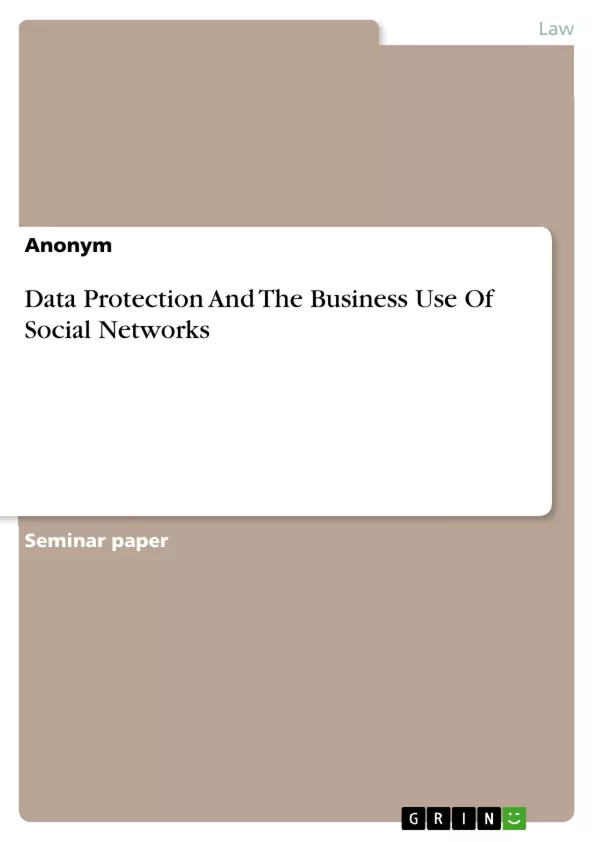This assignment provides an overview of the complexity of data protection and the usage of social networks that US-based companies have to deal with. The world wide web has brought many new opportunities for companies to globalize, expand and to make work processes paperless.
Looking at the findings conducted for data protection laws it is a big surprise that the US has not implemented a federal data protection act, even though data protection and privacy is seen as a human right for most economically strong countries including Canada and Europe. Thus, the US data protection acts are split into several industries and works in a ‘patchwork system’. This system made it more difficult for the US to trade with the European Union before both parties agreed on an EU-US Privacy Shield to protect European customer data. Secondly, this assignment identifies that Social Networks should not be included in the recruitment process of an employer but can be used as a platform for employees to discuss work processes or for the companies to promote its products and services. This is a legal procedure as long as the content posted is not illegal, obscene, incorrect, defamatory or invasive of privacy. The acceptance and openness for the US citizens to freely communicate online is a consequence of Americas ‘free speech’ philosophy. Additionally, a Business providing its own social network in form of a blog, content community or social media website is not held liable for the content that is being posted by users, however, the service provider has to have a system in place to be able to delete illegal content.
Inhaltsverzeichnis (Table of Contents)
- Executive Summary
- Table of Contents
- List of Abbreviations
- Introduction
- Objective
- Methodology
- Main Part
- Data Protection
- Health Insurance Portability and Accountability Act
- Fair and Accurate Credit Transaction Act
- The Federal Trade Commission Act
- Financial Services Modernization Act
- Data Protection for transatlantic data flows
- The Business Use of Social Networks
- Social Networks
- Social Networks and the Employment Relationship
- Applicant Screening Laws
- User Generated Content & Copyright
- Trademarks
- Conclusion
- Bibliography
- Online Journal
- Press Release
Zielsetzung und Themenschwerpunkte (Objectives and Key Themes)
This assignment aims to analyze and identify the effectiveness of the US data protection system, a fragmented approach, in comparison to robust national data protection policies implemented in other countries. It also delves into the business use of social networks within the United States, focusing on employee use, the influence of social networks on recruitment processes, and the legal use of social networks as a communication tool for businesses under US law.
- US data protection regulations
- Comparison of US data protection policies with those of other countries
- The business use of social networks in the US
- The impact of social networks on employment practices
- The legal framework surrounding social media use in business communication
Zusammenfassung der Kapitel (Chapter Summaries)
The introduction highlights the increasing need for data protection regulations in the digital age, particularly in light of the growth of e-commerce, social networks, and the Internet of Things (IoT). It discusses the absence of a national data protection policy in the US, contrasting it with the established policies in the EU and Canada. The chapter also explores the significance of the "Safe Harbor Privacy Principles" and its transition to the Privacy Shield framework in response to the evolution of data privacy concerns.
The objective section outlines the primary goals of the assignment: to analyze the efficacy of the fragmented US data protection system and to examine the business use of social networks within the US, specifically focusing on employee engagement, recruitment practices, and legal frameworks for business communication.
The main part of the assignment delves into the complexities of data protection in the United States, exploring various industry-specific regulations like the Health Insurance Portability and Accountability Act (HIPAA), the Fair and Accurate Credit Transaction Act (FACTA), the Federal Trade Commission Act (FTCA), the Financial Services Modernization Act (FSMA), and the legal framework for transatlantic data flows. This section also examines the implications of social networks for business and employment, covering topics like employee use of social media, applicant screening laws, user-generated content and copyright, and the role of trademarks.
The chapter on data protection delves into the US's "patchwork" system of regulations, contrasting it with the more comprehensive approach of other countries. It examines the impact of this fragmented system on transatlantic data flows and the evolution of data protection policies from the "Safe Harbor Privacy Principles" to the Privacy Shield framework.
The chapter on the business use of social networks focuses on the legal implications of social media use in the workplace, particularly employee engagement, recruitment processes, and business communication. This section highlights the importance of addressing user-generated content, copyright issues, and the role of trademarks within the context of social media platforms.
Schlüsselwörter (Keywords)
The primary keywords and concepts explored in this assignment include data protection, social networks, business use, US law, employment practices, privacy, regulation, transatlantic data flows, Safe Harbor Privacy Principles, Privacy Shield framework, user-generated content, copyright, trademarks, and the impact of technology on business and society.
- Arbeit zitieren
- Anonym (Autor:in), 2016, Data Protection And The Business Use Of Social Networks, München, GRIN Verlag, https://www.grin.com/document/429695



